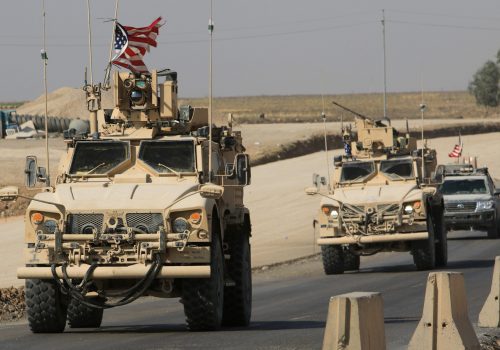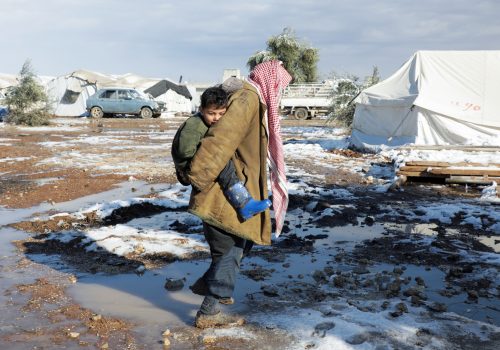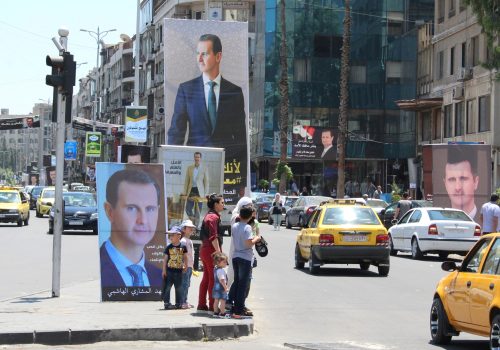The politics of early recovery aid in Syria. Is it actually reconstruction aid?
On November 24, 2021, the US Treasury Department’s Office of Foreign Assets Control (OFAC) announced its decision to expand authorizations for non-governmental organizations (NGOs) to engage in additional activities and transactions in Syria. Examples of such new exemptions include: the restoration of health services, rehabilitation of local schools, refurbishment of mills, protection of cultural heritage sites, and purchase of refined petroleum of Syrian origin for use within the country as well as engaging in certain transactions with parts of the government in Damascus.
This decision facilitates the provision of aid across Syria by ensuring that NGOs don’t contravene with existing US sanctions, highlighting America’s increased openness toward early recovery projects in the country. Following the decision, OFAC Director Andrea Gacki stated that Washington “remains committed to ensuring that humanitarian assistance from the international community, including early-recovery-related humanitarian activities, reaches Syrian civilians.”
However, the exceptions from OFAC raise important questions. First, where is the line drawn between reconstruction and early recovery? Second, what does early recovery reveal about Washington’s grand strategy in regard to Syria? Finally, what implications will this decision have on the country and who is set to benefit from it?
The difference between early recovery and reconstruction
The concept of early recovery has been a focal point of contention in humanitarian circles in recent years. Due to the absence of consensus, it has become open to different interpretations. Broadly speaking, and according to the United Nations Development Programme, early recovery is “an approach that addresses recovery needs that arise during the humanitarian phase of an emergency.” Put another way, this may be defined as the restoration of basic and essential services through which affected individuals can support themselves more sustainably rather than being constantly dependent on aid organizations to meet their basic needs.
Despite the absence of consensus over its definition, our reading of the literature and discussions with humanitarian experts suggest there are three differences between early recovery and reconstruction. First, reconstruction is planned and executed by the state, while early recovery is planned and executed by aid organizations, whether centralized under one administrative body—such as the United Nations (UN)—or by individual organizations
Second, while early recovery is a form of humanitarian assistance, reconstruction isn’t. Reconstruction can come in the shape of concessionary loans through unilateral and multilateral organizations—such as the International Monetary Fund or the World Bank—while early recovery is a form of aid and doesn’t need to be reimbursed.
Third, like other forms of humanitarian assistance, early recovery is humanitarian needs-based, while reconstruction doesn’t have to be since the state administers it. Early recovery aid can be viewed as an activity between the currently prevalent approach of focusing on basic humanitarian aid—food, shelter, and WASH (water, sanitation, and hygiene) services—and reconstruction.
For years, humanitarians have stressed the importance of early recovery projects in Syria to sustainably improve the living conditions of those still living in the country. More recently, UN agencies, which don’t adhere to unilateral sanctions to begin with, have also called for greater support and taken steps toward early recovery.
Additionally, various UN officials held meetings with the Syrian government recently. Last November, the World Food Programme (WFP) executive director met with Syria’s foreign minister, while a representative of the UN Population Fund (UNFPA) met with Syria’s local administration and environment minister.
The WFP focused on expanding the scope of the program’s work in Syria, establishing sustainable projects, and transitioning from emergency humanitarian assistance to early recovery and medium- and long-term projects. On the other hand, UNFPA focused on developing a closer partnership with the government to achieve sustainable development and capacity-building. Despite the push for more support from Western governments for early recovery, the pleas of humanitarian and UN agencies have mostly fallen on deaf ears.
Politics of early recovery
The Syrian regime has a proven record of siphoning and weaponizing aid, whether by distributing it exclusively in loyalist areas, manipulating the exchange rate of aid transfers, corruption, or hiring aid and procurement workers from its circles. This has deterred donor governments from funding non-essential items such as early recovery aid. Additionally, implementing early recovery programs in regime-held territories has become increasingly difficult due to US sanctions, which have deterred donors and inhibited aid delivery.
Early recovery aid, when reaching intended beneficiaries, improves the living standards of everyday Syrians, and Washington hasn’t shied away from indicating this is an important part of its policy. Simultaneously, the United States is also aware that the restoration of essential services through early recovery will consolidate the Bashar al-Assad regime’s grip on power, thus, lowering its desire to come to the negotiating table to arrive at a lasting settlement to the conflict.
Therefore, the trade-off for US policymakers is about the time horizon. Does providing only basic needs assistance hurt ordinary Syrians in the near term but enhance the chances for a political settlement in the long term? Or is the opposite more accurate?
The apparent softness under the Joe Biden administration on early recovery comes as a concession to Russia in exchange for the renewal of cross border aid to northwestern Syria through the UN, which recognizes that “humanitarian activities are broader than solely addressing the immediate needs of the affected population and should include support to essential services through water, sanitation, health, education, and shelter early recovery projects.”
The ambiguity of the definition of early recovery has also been reflected in the lack of consensus among states active in Syria on their position toward early recovery. France, for example, insists that early recovery shouldn’t include infrastructure projects while Jordan argues otherwise. Paris worries that early recovery assistance may be misinterpreted as a license for reconstruction and other forms of non-humanitarian development aid with little or no oversight.
However, Washington’s quid pro quo with Moscow need not be interpreted as a major shift in US foreign policy on Syria. Rather, it’s an attempt to reform its existing sanctions regime—not least due to ongoing pressure from Russia. This is illustrated by the fact that, just twelve days after its decision to ease restrictions on early recovery, OFAC issued a new set of sanctions targeting five regime officials responsible for a number of notorious atrocities, including the chemical weapons attacks on Eastern Ghouta in 2013 and Khan Sheikhoun in 2017.
Who benefits from easing restrictions on early recovery?
The humanitarian situation in Syria is extremely dire. Around 90 percent of Syrians live in poverty while 60 percent are food insecure. A severe drought—the worst in decades—has further exacerbated the risk of a full-fledged humanitarian catastrophe.
The easing of restrictions on early recovery will slightly ease the suffering of civilians by increasing the margin of operational freedom of existing aid providers, especially in regime-held areas where early recovery activities are particularly lacking. The impact will be more noticeable for NGOs, as UN agencies don’t adhere to sanctions to begin with. However, making it easier to provide early recovery aid won’t improve the humanitarian situation alone. The overall impact is contingent on future funding.
If it were to come, the enhanced funding of early recovery initiatives in regime areas would likely be raised by Western NGOs, not governments. In 2021, the early recovery and livelihoods cluster of the UN’s Syria Humanitarian Response Plan, which Western governments predominantly fund, was just 6.9 percent funded—the lowest rate since the outbreak of the conflict in 2011. The US government has previously refrained from funding the UN’s early recovery activities in regime-held areas over the past few years, instead focusing on providing earmarked funding for specific UN operations in regime-controlled territories to areas other than early recovery. The same reluctance is broadly shared with European donors. However, this may change in the years to come.
Assuming a significant increase in funding to early recovery projects, the overall impact on Syrians’ well-being will depend on the share of aid siphoned by the Assad regime and the time horizon. While civilians will undoubtedly benefit in the near term, the impact in the medium and long term is likely to be negative, as it will exacerbate the entrenchment of warring parties on the ground—chiefly that of the regime—and lower the likelihood for a lasting political settlement. Damascus is also set to benefit indirectly, as countries aiming to normalize ties with the regime will interpret the easing of restrictions on early recovery as another sign of softening Western objections to normalization.
Policymakers in Washington need to ensure that early recovery programs don’t transition into full-fledged reconstruction without tangible progress on the political front in line with UN Security Council Resolution 2254, which calls for a ceasefire and a political settlement in Syria. Additionally, Washington should implement mechanisms to effectively track how its exemptions are affecting aid distribution on the ground and who exactly is benefiting from early recovery programming. The stakes remain high and immediate action is needed to avoid further suffering and enrichment of the regime from aid. This can only be achieved with a grand vision by the Biden administration to resolve the conflict that remains vague to date.
Samy Akil is a Visiting Fellow at the Centre for Arab and Islamic Studies at the Australian National University and a non-resident research fellow at the Operations & Policy Center (OPC). Follow him on Twitter: @Sakil963.
Dr. Karam Shaar is the Researcher Director at the Operations & Policy Center (OPC) and a non-resident scholar in the Middle East Institute. Follow him on Twitter: @Karam__Shaar.
Further reading
Mon, Jun 14, 2021
What choices remain for the United States in Syria?
Issue Brief By
In a new issue brief Nate Rosenblatt and Jomana Qaddour describe the challenges the United States faces in Syria, including Russia's attempt to expand the UN Strategic Framework as well the struggle to keep the UN humanitarian border crossings open in northern Syria.
Fri, Jan 21, 2022
The Biden administration’s Syria policy sets a path towards disengagement. Here’s why it’s problematic.
MENASource By Abdulrahman al-Masri, Reem Salahi
It appears that the Joe Biden administration isn’t only deprioritizing Syria due to a cramped foreign policy agenda, but more clearly pronouncing a lack of strategic interest and an official approach of disengagement.
Fri, Sep 17, 2021
Syria after the fall of Kabul: A European perspective
MENASource By Michel Duclos
There is at least one common factor between Syria and Afghanistan: just as the Taliban has not changed once it took back power, the Bashar al-Assad regime will not change once its power is affirmed.
Image: A worker unloads bags and boxes of humanitarian aid from the back of a truck in the opposition-held Idlib, Syria June 9, 2021. Picture taken June 9, 2021. REUTERS/Khalil Ashawi


